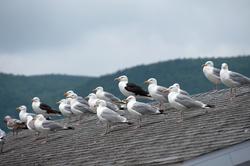 If you own or manage a rooftop nightclub, you know that birds can be a problem. Before you open, these flying pests can leave droppings all over your tables, sofas and chairs, leaving you with a nasty cleanup job. If your club features a pool or spa, bird droppings can pose a real headache, requiring an expensive cleanup. After you open, when guests start streaming in, the presence of birds on tables, chairs and sofas can be a turn off. Birds are attracted to your club because of all the finger foods on tables and scraps that have fallen on the floor. You also need to keep birds away from decorations, signage, bar areas, lighting fixtures and sound equipment. No matter how you look at it, without effective bird deterrents, you’ll be at the mercy of pest birds that can quickly ruin the image of your club. Fortunately, there are some very effective bird deterrents you can install that will keep birds away from your club. Here are three today’s bird control experts recommend: 1. Bird Spikes Proven worldwide, Bird Spikes are the anti-perching, anti-roosting devices that will keep birds off signage, light posts, awnings, fixed umbrellas, rooflines and virtually any elevated structure. Today’s plastic bird spikes come in a rainbow of colors—including crystal clear, brick red, light grey, brown, black and tan—to blend in with your club’s façade. The best plastic bird spikes are made of rigid UV-resistant unbreakable polycarbonate to resist weathering and sun exposure. These spikes come in 3-, 5- and 7-inch widths to protect areas up to 7 inches wide. The base of the spiked strip is just 1.5” wide, so it’s easily installed on narrow fixtures. 2. Bird Chase Super Sonic Easy to set up, the Bird Chase Super Sonic broadcasts predator and distress calls that frighten birds away. The Bird Chase device can be set up to emit distress and predator calls day and night. And it can broadcast distress and predator calls for as many as 22 different types of birds. So one device takes care of all your bird problems. Incidentally, these sounds are not annoying to humans, since they resemble natural birdcalls. And unlike ultrasonic devices, the Bird Chase device emits sounds birds can actually hear. 3. Plastic Bird Netting Easy to install, Plastic Bird Netting can be used to deny pest birds access to overhangs, canopies, and electrical control and food storage areas. Bird netting is available in several mesh sizes to deter various types and sizes of birds. For larger birds, like pigeons or seagulls, a 1-1/8-inch to 2-inch mesh size is recommended; for sparrows or starlings, a 3/4-inch mesh size would do. The best bird netting is UV- stabilized, flame resistant and rot- and water-proof. Bird netting is even available in different colors--like white, stone and black, so it’s barely visible.

Pigeons can create all sorts of annoying problems for today’s property owners. - Pigeons Carry Diseases. These “dirty birds” often gather in huge flocks on buildings. When they do, they pose a threat to human health and safety. Their droppings can carry a virus called encephalitis, which can cause an inflammation of the brain. In fact, they can carry any of 60 known diseases, including salmonellosis and ornithosis, a disease similar to viral pneumonia.
- The Stench & Mess of Droppings. This can negatively impact the appearance of a home or business. The sheer weight of bird droppings has led to the structural collapse of ceilings. The slip-and-trip hazards bird droppings leave on walkways, steps and entrances can be especially dangerous.
- Major Clean-Up Costs. For businesses, this can become a major expense. Removing nesting materials and accumulated droppings can sometimes require specialists in "moon suits" to protect them from disease-carrying clouds of droppings created when hardened droppings are sand blasted away.
- Fire Hazard. Pigeons roosting and nesting near electrical equipment and wiring can create a fire hazard.
Using pellet guns and poisons to get rid of pigeons can be dangerous to pets and children. These measures are also considered inhumane. Egg removal, birth-control pills and food deprivation take three to five years to be effective. Fortunately, there are far more efficient, expedient and humane ways to achieve pigeon control. - Bird Slopes Blend In to Keep Pigeons Out. These angled, slippery PVC panels simply won’t allow pigeons to purchase a landing. Ideal for the many 90-degree nooks and crannies found in most structures, the panels even come in several colors to blend in with a structure’s aesthetics. The best bird slope panels are made of UV-stabilized polycarbonate to last longer in tough outdoor weather.
- Bird Wire Systems Keep Pigeons off Balance. Most birds prefer a stable landing area. Bird wire systems provide anything but that. These post-and-spring-wire set-ups make pigeons “wobble and weave ‘til they leave.” Ideal for railings, rooftops and similar extensions where pigeons prefer to land, wire systems install easily and are often used on Federal and State government buildings. The best bird wire systems feature nylon coated stainless steel wire for lasting durability.
- Bird Spikes Create a No-Landing Zone. Making it virtually impossible for pigeons to land, Bird Spikes come in rigid UV-resistant unbreakable polycarbonate or longer-lasting stainless steel. These pigeon control strips even come in a variety of colors--including white, tan, gray, black, brown, brick red and crystal clear—to make them far less conspicuous. The bird spikes can be easily glued, screwed or nailed to any surface.
- Sonic Repellers Drive Pigeons Away. Pigeons won't nest or roost near the sound of peregrine falcons (a pigeon's dreaded enemy) defending their territory. And that’s exactly what Sonic Bird Deterrents imitate—the sounds of their most fearsome enemy attacking and squawking. Sonic repellers repeat these sounds on a regular basis. And they won’t annoy pets or humans.
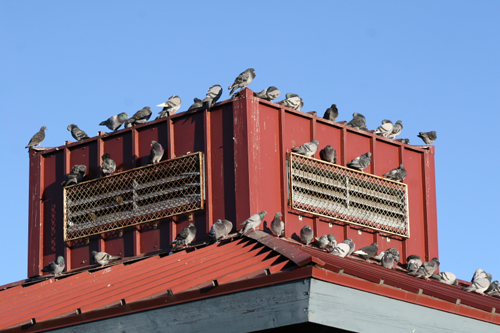
by Alex A. Kecskes
Pigeons are smarter than the average bird. In fact, they're one of the most intelligent birds around. They can recognize their own reflection in a mirror, a feat only 6 species and no other non-mammal can perform. They can also recognize all 26 letters of the English alphabet. They can even differentiate between two different human beings in a photograph when rewarded with food for their efforts. It's no wonder pigeon control has presented such a challenge.
The Days of Shotguns, Cannon and Poisons Are Over
There's a whole new breed of pigeon control solutions. Borne out of society's increasing need to control the damage caused by pigeons, these new devices have proven successful in deterring the winged pests from our homes, boats, parks and commercial buildings. Property owners began to realize that the cute little bird had a nasty habit of pooping all over everything, that these droppings could transmit any of 60 known diseases. And amidst the rising chorus of environmentalist's objections to killing or harming these birds, the mantra of humane deterrent was born.
Spiked No-Landing Zone
Pigeon's fly well but sooner or later, they have to land. And when they do, they don't want to make things complicated. Bird spikes do that. These pigeon control devices have blunted splayed-out spikes that no bird wants to deal with, which makes pigeon spikes both humane and highly effective. Spikes are available in rigid U.V.-resistant unbreakable polycarbonate or high durability stainless steel. You can also get girder spikes, recommended for keeping pigeons off girders or I-beams. Finally, there's the gutter spike, which will keep your rain gutters free of nesting pigeons.
Trap and Release
Here's an effective pigeon control device for those with just a few annoying pigeons. The pigeon motel is basically a live-trap cage that lets you move the offending birds to an out of the way location. These sturdy galvanized wire cages can be used indoors or out. The typical trap will have a funnel trap door that let birds in and an easy access door that lets you get them out.
The Net Result: No Pest Pigeons
Bird netting is an ideal pigeon control solution that relies basically on the barrier method of deterring pest birds. Bird netting has been widely used to keep pigeons from gathering on rooftops, courtyards, patio covers, and other large areas. The best netting is made of ISO 1806 mesh test polyethylene fabric, U.V. stabilized, flame resistant and rot and waterproof.
Pigeons Will Make Tracks…and Leave
Commercial property owners have used electric track devices as an effective pigeon control solution for years. Pigeons are quick to leave after landing on these electrified tracks. One mild jolt of juice is usually all it takes to convince them this is no place to land or nest. Ideal for ledges, signs and other elevated or out-of-reach areas, the tracks install easily and are virtually invisible from below.
Sounds like Pigeon Control to me
Pigeons, all birds, really, are fairly tuned in to sounds around them. Which is what sonic pigeon control devices fully exploit. These nifty devices produce a variety of annoying distress and predator calls. One sonic system emits the distress and predator calls of over 22 types of birds. This includes the sound of Peregrine falcons--a pigeon's worst enemy--defending their territory. The best sonic systems will continually alter the pitch, frequency, timing and intensity of the sounds they emit. Since the sounds are emitted in a random fashion, pigeons are constantly on a state of alert--a condition not conducive to nesting. Sonic bird deterrents are ideal for gardens, rooftops, courtyards, pool areas and other large open areas.
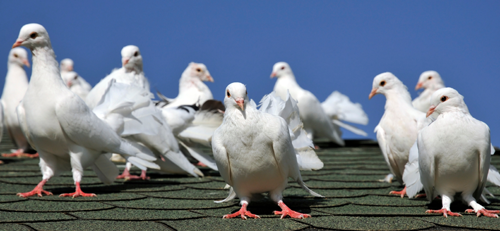
Launceston is a city just north of the state of Tasmania, Australia, at the juncture of the North Esk, South Esk, and Tamar rivers. It is the second largest city in Tasmania with a population of over 100,000 people. The city recently sought advice on how to get rid of pigeons. A recent pigeon plague across inner Launceston rooftops created a smelly mess, cost local businesses thousands and threatened to potentially spread serious diseases.
The pigeons made their nests in some of the city's landmark buildings, including the old gasworks, the Telstra tower, and several of the city's historic banks and government institutions.
Some referred to the putrid pigeon infestation as a major nuisance and potentially toxic. The problem got so bad that one office was forced to close while hundreds of pigeons and their chicks were destroyed as the building's roof cavity was cleared and cleaned. Clearly, something had to be done to get rid of the pigeons.
Business owners noted that the pigeon problem was worse than dealing with rats. People were warned not to feed the pigeons to reduce the amount of droppings, which not only carry disease like salmonellosis, aspergillosis and histoplasmosis, but can create dangerous slip-and-fall liability for a business.
Commercial property owners demanded the problem be addressed. Some businesses had to move into temporary alternative workplaces in remote locales. Other building owners spent thousands removing the pests. The roof of a former bank drew hundreds of pigeons. The bird droppings were knee deep and had to be pumped into a waste disposal truck. To get rid of pigeons, they had to cast a bird net over the entire roof and put up bird spikes.
Bird netting works well to get rid of pigeons. For pigeons, a 1-1/8-inch mesh size is ideal.
When installing netting on rooftops or other outdoor areas, U.V. stabilized, flame resistant and rot- and water-proof netting is best. One brand of bird proof netting currently being marketing is said to be able to withstand severe temperature extremes--from 250-degree Fahrenheit to "sub-zero" temperatures. Non-conductive netting is ideal for installations where electrical conductivity or radio frequency interference could cause problems.
Another way to get rid of pigeons is to use bird spikes. These come in either rigid U.V.-resistant unbreakable polycarbonate or high strength, durable stainless steel. The spikes look threatening, but they won't harm birds or people. They have even been approved by a number of humane groups worldwide--including the U.S. Humane Society and PICAS (Pigeon Control Advisory Service). Bird spikes are available in various sizes and colors. Thee stainless steel spikes come in 3-, 5- and 8-inch widths; their plastic counterparts come in 3-, 5- and 7-inch widths. The plastic spikes are more economical, and they can be used near RF transmission equipment like cell phone antennas because they won't interfere with radiated energy. Bird spikes even come in a variety of colors--like white, tan, gray, black, brown, brick red and crystal clear.

There are about 146,000 retail gas stations and convenience stores in the United States. That's the good news for late-night shoppers and folks running out of gas. The bad news is, many of these stores lack effective pigeon control, which means feral pigeons can pretty much do what they please.
The last thing customers want to touch is a pump handle covered with pigeon poop. Or see the roof or hood of their car splattered with poop when they return with snacks in hand. Theses stores have a pigeon problem because the pesky little birds love to roost in gas station and store canopies. And they do so hundreds at a time.
Without effective pigeon control measures, this often-neglected nuisance can cost commercial property owners thousands of dollars in maintenance and repairs. Keep in mind that just one healthy pigeon creates an average 66 pounds of droppings each year. If you've got a flock of these birds nesting in your gas station canopy, you're looking at several tons of poop over a short period of time.
If you think the damage is all cosmetic, consider what happened to a gas station canopy in Yuma, Arizona. A build-up of pigeon poop clogged up the canopy's drains, causing it to crash to the ground after a heavy rain. A Hummer and a BMW were smashed in the process. Needless to say the gas station owner's insurance policy went up.
Roosting and nesting pigeons can create an unsightly mess on signage, windows and gas pumps. They can clog drains, block out security cameras and jam doors and windows. They can also wreak havoc with rooftop AC units.
As if that weren't enough to implement aggressive pigeon control measures, pigeon droppings are also breeding grounds for a number of diseases. Fecal droppings in pigeon infested canopies can create an environment for bacteria and fungi spores to grow and multiply. This filth can attract mites, black widows, rats, mice and other vermin.
Consider the problems such an environment presents to a gas station that has a full-service food preparation kitchen. If you've got flocks of pigeons gathering on your rooftop or near air induction vents, these air conditioning and air circulation systems could easily suck in pigeon dander, spores and viruses.
Cleaning roofs, parapets, HVAC, ventilation systems and other roosting sites can aerate these areas and increase the risks of exposure to disease. Gas station and store canopies offer the ideal place for pigeons—plenty of food in garbage cans and safe roosting areas.
Failure to implement pigeon control measures can be very expensive in the long run—repairing a canopy can set you back as much as $100,000. And that doesn't include lost sales, city or health violation fees or full canopy replacement.
Some effective pigeon control measures include bird netting, which works to effectively exclude the pests. You can also use chemical fogging systems to drive out entrenched flocks. Both measures are safe to use on pigeons and will save you a lot of grief and expense.
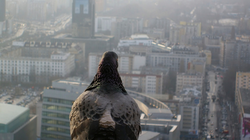 By Alex A. Kecskes One of the many concerns facing today’s property managers is pigeon control. Pigeons are pest birds that remain unprotected by the Migratory Bird Treaty Act of 1918. They can cause property managers a lot of grief. So what attracts pest pigeons to a commercial building, its edifices and rooftops? A combination of factors. First off, commercial buildings usually offer covered areas that provide shelter from the elements. Things like rooftop AC units, electrical boxes, and ducting offer ideal places to nest and roost. Ledges and parapet walls offer high altitude perches for scouting predators and prey, especially if they overlook trash bins and dipsy-dumpsters. Also, if your commercial building is the only one in the area offering such vantage points, it will attract flocks of pest pigeons. Another attractive feature of your building may be that it lies close to ponds, fields, and electrical wires. And if you’re unlucky enough to have a flock of pigeons already nesting on your building, the droppings will attract other pigeons, making your building a prime gathering spot. In general, pigeons will be strongly attracted to nesting spots they have already claimed as their own. Without effective pigeon control measures, a pest pigeon infestation can result in costly and repetitive clean-ups. Long-term infestations. Can severely damage a commercial building’s facades, sills, parapet walls, roofing, water drainage systems and rooftop AC units. The annual damage/repair/cleanup cost of pest birds to commercial buildings is estimated to be in the hundreds of millions of dollars.
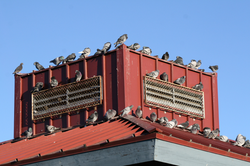 By Alex A. Kecskes If you own a commercial building, you no doubt have had problems with pigeons. In most cases, the larger the building, the bigger the problem. For strip malls, commercial centers, warehouses and other large structures, pigeons can cause all sorts of headaches for property managers and property owners. If your building has a flat roof, pigeon debris, feathers and droppings can damage AC units, ventilators and drainage areas. Pigeons love to gather around rooftop equipment, and as you know, AC units are not cheap. They cost plenty to maintain and repair. Without proper pigeon control, pigeon debris can stop up rain vents and gutters, causing flooding. Hundreds or even thousands of gallons of water trapped on a long flat roof can lead to structural problems and ultimately roof collapse. Once this occurs, you have a huge problem in terms of damage to inventory inside a building. Whether your building is covered by a roof made of wood shingles or tiles, pigeons waste can be highly destructive. The acidic content of pigeon droppings can eat into the sub-roofing materials and eventually cause leaks. Bird droppings can also deface and damage your expensive signage—whether your signs are fabricated of metal, wood or plastic. Pigeons can also create an image problem. Bird droppings on entryways, walkways, display windows, benches, umbrellas and nearby lampposts can be a real turn off (and costly daily cleanups for you).
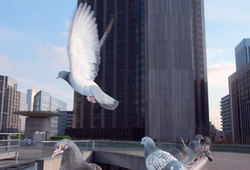 By Arlene Connelly Many urban dwellers are unaware that more than 60 human diseases — including avian flu, salmonella, E coli and West Nile virus — are related to pigeons, other pest birds and their droppings. Besides being a public health issue in many cities, they often create a safety hazard for pedestrians, and they carry dangerous parasites and harmful bacteria. Some of these illnesses can even be fatal to humans; they can be contracted through contact with the skin and exposure through inhalation as people go about their daily activities. Why pest pigeons are especially dangerousPigeons are generally considered to be “the number one bird pest” in America today, their numbers are increasing, and their nesting instincts are strong. They usually mate for life, live in communal flocks that travel together, and tend to roost where they can find adequate food and shelter. Along with that, experts in the field now consider pigeons to be a genuine “urban menace,” threatening the quality of life in America’s great cities, including San Francisco, Chicago and New York. Pigeon droppings can be found on walkways, roofs, window ledges and the sides of some of our finest buildings— anyplace these birds can access. This is especially dangerous around air vents and areas that surround water sources; the germs they carry can easily be transmitted to humans, especially those with a weakened immune system. They also attract insects that can spread disease as well, creating serious liability issues for businesses and restaurateurs. The corrosive affect of pest pigeon droppings results in extensive and expensive damage to our public buildings and monuments, and they can cause a serious disaster like the collapse of the Minnesota Bridge. Feathers, droppings and nest paraphernalia can also be sucked into pipes and vents, creating a fire hazard in a city’s high-rise buildings where people work and live.
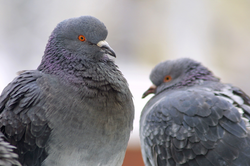 by Alex A. Kecskes The ubiquitous pigeon has been man's friend and foe for centuries. Rising to nuisance level as they invaded our cities and towns, pest pigeons cause over one billion dollars annually in damage and cleanup costs. It's not surprising. Pigeon poop alone can cause all sorts of damage. It can eat into wood and metal, ruin fine stonework, and seize up AC units. Worse yet, pigeon poop is teaming with bacteria, fungi and parasites, which is why it poses such a high health risk. After all, pigeon droppings have been known to carry any of 60 known diseases. And no less hazardous are the fleas, mites and ticks that infest pigeons. It's no wonder that pigeon control has become so important. Thankfully, there are a number of highly effective pigeon control methods on the market.. One can't talk about pigeon control without mentioning the various Bird Scare products currently available. These flash tape banners wave, flap and crackle in the breeze to frighten pigeons looking for a safe place to land and roost. The same holds true for the inflatable, Bird Scare Balloon. Imprinted with menacing looking predator eyes, these devices turn and flail in the breeze to frighten pest pigeons away.
|









 RSS Feed
RSS Feed